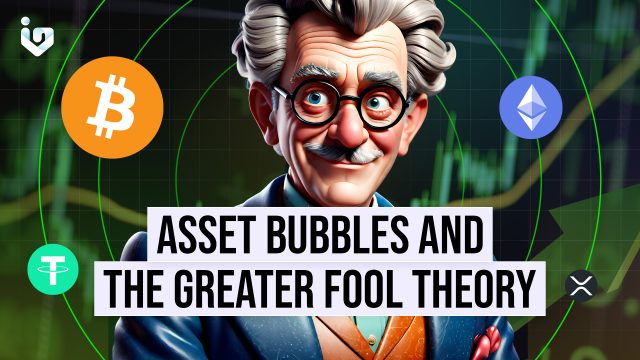An asset bubble is a situation where the price of an asset, such as a stock, a commodity, or a cryptocurrency, rises far above its intrinsic or fundamental value, driven by excessive speculation and irrational exuberance. Asset bubbles are often fueled by positive feedback loops, where rising prices attract more buyers, who push the prices even higher, creating a self-reinforcing cycle. Asset bubbles are also characterized by high trading volume, media attention, and public interest.
However, asset bubbles are unsustainable and eventually burst, leading to a rapid and sharp decline in prices, as well as financial losses and distress for the investors who bought at the peak. Asset bubbles can have negative consequences for the economy as a whole, as they can divert resources from productive activities, create financial instability, and trigger recessions.
Greater Fool Theory
The greater fool theory is a behavioral finance concept that explains why asset bubbles can persist for a long time, despite the lack of fundamental support. The greater fool theory states that, during a market bubble, one can make money by buying overvalued assets and selling them for a profit later, because it will always be possible to find someone who is willing to pay a higher price. This someone is called the “greater fool”, who is more optimistic, more irrational, or more ignorant than the previous buyer.
The greater fool theory implies that investors do not care about the intrinsic value of the asset, but only about the price movements and the expectations of other investors. Investors buy assets not because they believe they are worth the price, but because they believe they can sell them to a greater fool later. The greater fool theory also suggests that investors are influenced by emotions, such as greed and fear, as well as by social and psychological factors, such as herd mentality, confirmation bias, and overconfidence.
What are some examples of asset bubbles and the greater fool theory? History is full of examples of asset bubbles and the greater fool theory in action. Some of the most famous ones are:
The Tulip Mania
In the 17th century, the Netherlands experienced a craze for tulip bulbs, which were considered a luxury and a status symbol. The prices of tulip bulbs soared to astronomical levels, reaching as high as 10,000 guilders for a single bulb, which was more than the annual income of a skilled worker. People traded tulip bulbs for land, houses, and other valuable goods. However, in 1637, the bubble burst, as the demand for tulip bulbs collapsed, and the prices plummeted to near zero. Many investors were left bankrupt, and the Dutch economy suffered a severe shock.
The Dot-com Bubble
In the late 1990s and early 2000s, the internet and the new technologies associated with it sparked a frenzy of investment and speculation in the stock market. Many dot-com companies, which had little or no revenue, profits, or business models, saw their share prices skyrocket, reaching absurd valuations. Investors were lured by the promise of the new economy, and the potential of the internet to revolutionize various industries. However, in 2000, the bubble burst, as many dot-com companies failed, and the Nasdaq index, which was dominated by technology stocks, plunged by more than 75%. Millions of investors lost their money, and the US economy entered a recession.
The Bitcoin Bubble
In 2017, the cryptocurrency Bitcoin experienced a massive surge in popularity and price, reaching a record high of nearly $20,000 per coin. Bitcoin and other cryptocurrencies attracted investors with their features of decentralization, anonymity, and innovation. However, Bitcoin also faced many challenges, such as regulatory uncertainty, security breaches, scalability issues, and volatility. In 2018, the bubble burst, as the price of Bitcoin dropped by more than 80%, and many other cryptocurrencies lost even more value. Many investors who bought Bitcoin at the peak suffered huge losses, and some even lost their entire savings.
What are the lessons from asset bubbles and the greater fool theory?
Asset bubbles and the greater fool theory teach us some important lessons about investing and financial markets, such as:
– Do not follow the crowd blindly: Asset bubbles are often driven by herd behavior, where investors mimic the actions of others, without doing their own research or analysis. This can lead to irrational and inefficient markets, where prices deviate from fundamentals. Investors should be independent and critical thinkers, and base their decisions on sound logic and evidence, rather than on emotions or opinions.
– Do not confuse price with value: Asset bubbles are also driven by the greater fool theory, where investors buy overpriced assets, hoping to sell them to someone else at a higher price. This can create a false sense of security and profitability, as investors ignore the intrinsic value of the asset, and focus only on the price movements. Investors should be aware of the difference between price and value, and seek to buy assets that are undervalued, rather than overvalued.
– Do not be greedy or fearful: Asset bubbles are also driven by emotions, such as greed and fear, which can cloud the judgment and rationality of investors. Greed can make investors chase after unrealistic returns, and take excessive risks, while fear can make investors panic and sell at the wrong time. Investors should be disciplined and balanced, and avoid being swayed by emotions, but rather by facts and logic.
Conclusion
Asset bubbles and the greater fool theory are phenomena that occur frequently in financial markets, and have significant implications for investors and the economy. Asset bubbles are situations where the price of an asset rises far above its intrinsic value, driven by speculation and exuberance. The greater fool theory is the idea that, during a market bubble, one can make money by buying overvalued assets and selling them to a greater fool later. However, asset bubbles are unsustainable and eventually burst, leading to losses and distress for the investors who bought at the peak. Therefore, investors should be cautious and prudent, and avoid falling prey to asset bubbles and the greater fool theory.

